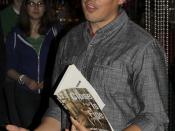After his conversion to Christianity, TS Eliot's works illustrate how drastically his worldview had changed and reflect his love and understanding of Christian principles. For example, through "Journey of the Magi," "Little Gidding," and Murder in the Cathedral, Eliot describes the struggles he experienced during his conversion and walk with Christ afterwards.
Using symbolism and imagery in his "Journey of the Magi," Eliot echoes "his state of mind in transition between his old and new faiths" (Behr). In this poem, he describes the wise men's journey towards baby Jesus, and symbolically towards Christianity, in a way most people have never heard. In one sentence of the poem, Eliot says, "Then at dawn we came down to a temperate valley, Wet, below the snow line, smelling of vegetation; With a running stream and a water-mill beating the darkness, And three trees on the low sky, And an old white horse galloped away in the meadow."
In this short excerpt, the phrase "beating the darkness" refers to the "triumph and victory of Christ, a conquering that could occur in the events of Christ's earthly life, His resurrection, and His return in glory at the end of time" (Dean). The three trees symbolize the three crosses on Calvary and the white horse refers to the conquering Christ in Revelations who conquers sin and death. All of these symbols contribute to the illustration of Eliot's conversion: how Christ's birth, death, resurrection have cleansed him from sin and renewed his spirit. The images of nature and conversion are representative of the ambiguity of the world. The images of nature are at times beautiful, as in the "fertile valleys" and "running streams," but are also portentous and dark in other portions of the poem. Images of conversion are also both...


